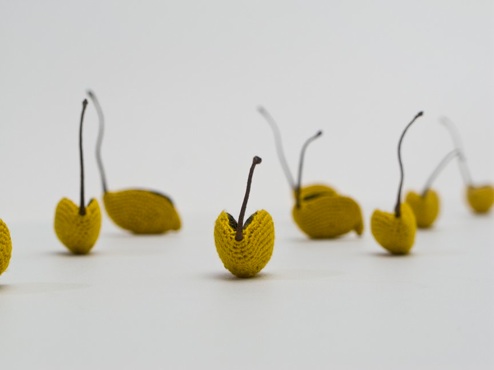Esther Traugot
Natural ALchemy
april 4 - may 29 2014
Esther Traugot
Natural ALchemy
april 4 - may 29 2014
Chandra Cerrito Contemporary




Esther Traugot
Fleet, 2013
seed pods (Grevillea Robusta, Australian Silver Oak), dyed cotton thread, wood board riser
1.5 x 9 x 22 inches
Oakland, CA Chandra Cerrito Contemporary is pleased to announce Natural Alchemy, a solo exhibition of works by Esther Traugot. Esther Traugot uses the intricacy of tiny crocheted works to blanket and warm the most delicate of objects…twigs, pods, seeds, eggs, dead honeybees. It is a gesture aimed at reinforcing the presence of such things while honoring their fragile nature. Beautifully hand-dyed cotton thread--a very specific shade of pollen-gold--reveals the form of each specimen, holding them safe from total decay and casting a brilliant glow.
Traugot meticulously covers each object with tiny stitch after tiny stitch, appearing not much bigger than moss spores in small rows. The calm, meditative state required in order to create such painstakingly crafted work is apparent, and the extended periods of time devoted to the task are embedded in each stitch. Many of these pieces stop just short of actually obscuring the object, leaving a bit of branch or twig exposed. In this manner, the artist creates a metamorphosis that is almost alchemical: process and material have a symbiotic quality, rendering gold from ordinary substances.
The artist must give herself over to the results, as what is revealed may not be visible until completion. Dedicated to this task, Traugot spends hours completing each piece, and has taken on the installation of a “stump forest” for her solo exhibition at Chandra Cerrito Contemporary.
The use of crochet in her work came later, after her formal training as a painter. The process was one she was familiar with, but it had not occurred to her to incorporate the skill in her work as a fine artist, “…being an artist meant being a painter,” she says. Having grown up in a rural area, the artist’s work as a painter includes fantastical landscapes and quiet botanical drawings of seeds and pods.
In collecting objects to work with, some things come to her fortuitously, others she may seek out. For a recent project at the Fullerton Arboretum, she set out deliberately to collect the specimens she found on the grounds, creating a series of works that were identified and labeled with their botanical names. Dead bees from a friend’s hive or finds from a walk in the woods or her mother’s garden may also generate material.
Traugot’s work inhabits space much like a museum of natural history, with the use of small shelves, vitrines, and bell jars accentuating their preciousness. She has developed a body of work that belongs to a genus and species of her own design.
-Essay by Claudia Tennyson

